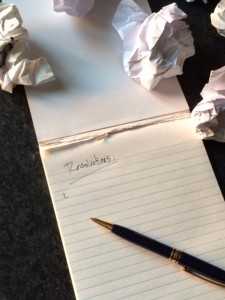By Caroline M. Cole
Wrapping up one year and launching into another, many of us will spend a few moments reflecting upon the successes and challenges of the past 12 months so as to identify ways to make this new year better than the last. Formally or informally listing resolutions, some of us will promise to spend quality time with family and friends, while others of us will commit to improving our health and minds. Others will devote their energies to finding better opportunities at work, or even a more fitting career path. And some individuals will focus on managing their finances, organizing their worlds, volunteering their time and talents, or simply enjoying life. Whatever goals make the final cut on this year’s list of resolutions, we should all resolve to become better communicators.
Consider, for example, that on August 4, 2010, at the Techonomy Conference in Lake Tahoe, Google CEO Eric Schmidt claimed that every two days, we create as much information as the “5 Exabytes of information created between the dawn of civilization through 2003… and the pace is increasing.” In other words, according to Schmidt’s calculations, we are creating the equivalent of information contained in 37,000 new libraries the size of the Library of Congress book collections every 48 hours. It’s a stunning revelation that has prompted countless reiterations and, of course, challenges—including one by the founder and CEO of RJMetrics, Robert J. Moore, who writes, “Based on the primary sources I’ve been able to piece together, the more accurate (but far less sensational) quote would be: ‘23 Exabytes of information was recorded and replicated in 2002. We now record and transfer that much information every 7 days.’” Yet regardless of the exact number of Exabytes we are creating or transmitting every 2–7 days, we are confronted with far more information today than previous generations, prompting us to consider the quality of the communication we personally are adding to mix—whether it’s a spontaneous text or tweet, an email, a YouTube video, a formal report or presentation, or an impromptu conversation with acquaintances or strangers.
We can tell ourselves that we should do better in the messages we transmit and in the interactions in which we participate but, as anyone who has made a New Year’s resolution can verify, the best intentions are seldom realized without sustained, purposeful action to create or develop better habits and, hence, better practices.
Psychologists define habits as learned behaviors that happen efficiently and automatically in response to particular situations or cues in the environment. People traditionally have argued that it takes 21 days to modify or establish habits but, in their research on habit formation, University College London health psychologist Phillippa Lally and her colleagues have found that, depending on the action being automatized, it can take people anywhere from 18–254 days, with an average of 66 days, to create a habit. Timeframes aside, Lally et al. conclude that, because some behaviors may require multiple repetitions for individuals to “reach their highest level of automaticity,” the creation of new habits requires persistent attention for “a significant period” if the desired behaviors are to become second nature; in other words, wanting to improve is not enough, nor is occasional, haphazard practice. Thus, if effective communication is to become an ingrained practice in our lives, we must make its learning and improvement a conscientious part of our routine.
Recognizing, however, that some things are easier said than done, this discussion offers concrete, manageable ways we can develop the habit of better communication, regardless of our current behaviors and practices.
* * *
To start, we must consider the forums in which we communicate and the types of interactions each forum values. We might then begin collecting representative copies of such materials that we generate on a regular basis. For instance, depending on our position, we might find ourselves writing due diligence reports, client pitches, press releases, grant proposals, collection notices, catalog copy, letters of transmittal, customer service follow-ups, product specifications, call center scripts, fundraising materials, project updates, performance reviews, executive summaries, and so forth on a monthly, weekly, or even daily basis. Certainly the details may change with each document’s production, but finding a typical or current version of each type of item can offer a tangible starting point for resolute improvement.
Once we locate sample materials, we should print out a copy of each type of document, stripping it of any identifying information before printing. The resulting hard copies will become forums in which to we can practice and refine various communication strategies and, in doing so, develop a databank of writing samples we can use as models or for inspiration when generating comparable materials, often under time constraints.
The next step is to schedule a standard time and, ideally, a consistent space in which to work with these materials. Lally et al. find that “as behaviors are repeated in consistent settings they begin to proceed more efficiently and with less thought as control of the behaviour transfers to cues in the environment that activate an automatic response.” Unfortunately, some behaviors and actions lend themselves more readily to consistent repetition than writing; therefore, we should resist trying to build consistency around particular documents or so-called writing problems and, instead, focus on building our routines around variables that can be more easily regulated, such as the approach we take or the time we spend.
For example, during each session we might commit to improving 1–2 paragraphs, or we might resolve to work for 15–20 minutes, or we might challenge ourselves to make one higher-order improvement or a select number of middle- and lower-order improvements. The objective is to create a tangible goal that has definitive starting and stopping points to minimize any frustration that can emerge from abstraction; these tangible goals can also help us schedule time to work explicitly on our writing and track our efforts in acquiring better communication habits, even when the individual writing practices we are addressing may vary from session to session.
Having identified recurring behaviors to ground the routines of each session, we then can move through the following tasks—either focusing on one document at a time, or addressing like-elements across multiple documents.
• Rate the document’s effectiveness. The goal of communication is to convey information in a way that generates the desired results—most commonly, the document’s target audience ultimately learns something, does something, or both. Additional considerations might be the time it took to achieve those results; whether any subsequent action was necessary on our part (or someone else’s) to clarify or nudge; and whether our relationship with the document’s readers has improved, declined, or remained the same since they’ve read our materials. To gauge the effectiveness of our writing in general and of documents in particular, then, we should start by assessing the extent to which each of the documents we’ve printed out has achieved its goals accurately, efficiently, and effectively.
Consider, for example, rating each document on a scale of 1 to 10, whereas 1 represents “failed to achieve” and 10 is “achieved” the desired results accurately, efficiently, and effectively. By using hindsight to give the document a numerical rating and by writing a phrase or two about the document’s impact on its target audience, we can begin to evaluate the products we write against the results they generate, helping us to build upon our success and to modify elements that may be hindering our efforts.
• Identify 1–2 things in the document that could have been more effective. Although it may be easier to see things we can or should improve in the documents we rate “5” or lower, documents rated “9” or even “10” can also be improved. After all, distance may help us see ways we could make a document more precise, concise, or reader-friendly if we had the luxury of time and perspective while generating the document. But that’s exactly what these improvement sessions aim to offer: the opportunity to identify ways we can enhance even our strongest materials and, in doing so, develop habits around the strategies and tactics that help us achieve our goals. By using scheduled sessions to recognize such areas, we can promote efficient automation of the best choices in our writing.
• Make changes on the hard copy of each document. Having identified areas to improve, we should then spend time actually revising the document; that is, we need to push ourselves beyond thinking about what we could do and test whether those possibilities work in practice. Using a hard copy, we should make corrections in a way that “shows our work,” allowing us to see the alternative, more effective strategy alongside the original. Then, as we move through the printouts we’ve made, we should transfer comparable changes from one document to the others, both reinforcing particular practices and ritualizing approaches that move us closer to the objectives we have when writing.
• Update electronic copies of the document. The final step might be to transpose the changes we make to an electronic copy of the document, perhaps generating templates or (de-identified) samples we can use as the starting point for creating comparable documents in the future. Certainly we would need to modify the document to accommodate the latest contexts, but starting with an increasingly polished framework of information would allow us to devote the time we have to making the document’s original information as effective as possible.
To supplement the documents we’ve personally written and, now, are in the process of revising or editing for greater precision and clarity, we might compile and annotate materials that have made us respond positively to the document’s content, objectives, or even the writers themselves. This compilation—coupled with the printouts of materials we are revising and editing—can provide a tangible databank of ever-evolving, continually improving models we can consult, emulate, and habituate, thereby ensuring the most effective presentation of our ideas in the documents we write.
The resolution to become better communicators can apply to exchanges beyond the written word but here, too, we may need motivation to move us beyond mere intension and into action. For that, we might consider what hidden camera-oriented shows can teach us.
In the 1960s, Allen Funt hosted a show on NBC television in which everyday, unsuspecting people were confronted by or otherwise incorporated into outrageous stunts and pranks before being placated with the show’s tagline: “Smile, You’re on Candid Camera.” In 2008, ABC began airing its own version of the hidden camera genre, adding a twist.
In Primetime: What Would You Do?, actors engage in various scenarios to see what bystanders and passersby would do if they were to witness conflict or even illegal activity taking place in public forums; for example, servers refusing to take the order of an interracial couple in a restaurant, parents criticizing children for their weight, shoppers insulting retail employees with disabilities, a gay couple being harassed in a sports bar, individuals sharing racist or sexist jokes on public transportation, people stealing or vandalizing items.
A scenario is enacted several times during an episode, but with each enactment, something is altered—the age, sex, or race of one or more of the participants; the introduction or removal children; clothing styles or other indicators of culture or socioeconomic class—allowing audience members to see what factor(s), if any, evoke and possibly alter responses from those witnessing the situation first-hand. Offering a voice-over commentary about each enactment and its variations, news correspondent and host John Quiñones invites those watching the show to consider what they would do if they were to find themselves in a similar situation, giving viewers the opportunity to answer in the comfort and safety of their own homes.
Our lives seldom work on endless loops that replay interactions with subtle variations, allowing us to test alternate approaches with minimal repercussions. As such, our spectatorial “could’ve-should’ve-would’ve” responses remain idealistically theoretical until we find ourselves in a similar situation. Unfortunately, by then it may be too late.
Contrary to what various resources seem to suggest, communication is not a one-size-fits-all endeavor; it is purpose-, participant-, and context-specific. As such, we need to consider how subtle variations—like those tweaked or altered in a Primetime broadcast—might affect the conversations we have. By adopting the mindset of the hidden-camera archetype and by mentally playing and replaying particular high-stakes interactions, altering variables each time, we may be able to foresee possible outcomes that can help us avoid the “Gotcha!” moment that bystanders observing the situation often see coming. As importantly, by predicting likely responses to varied approaches, we can identify, reinforce, and ingrain the communication strategies that can help us achieve our goals in the exchange.
As discussed in “Strive for Excellence, Not Perfection, in Communication,” it is not enough to participate in an activity if we aim to improve; that is, simply writing or speaking, even a great deal, will not make us better communicators. We must deliberately and systematically develop particular elements of our craft if we are to strengthen our overall performance. By resolving to become better communicators and by taking concrete, calculated steps to routinely move forward in our efforts, we can develop habits to consistently present ourselves in the best possible manner, ensuring the contributions we make to our generation’s Exabytes of information are, in fact, the best they can be.
Working toward Areté…
What actions will you take to improve your communication in the new year? Share your ideas in the space below.










